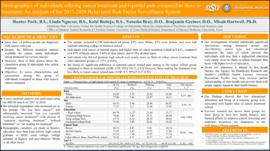| dc.contributor.author | Park, Hunter | |
| dc.contributor.author | Nguyen, Linda | |
| dc.contributor.author | Batioja, Kelsi | |
| dc.contributor.author | Bray, Natasha | |
| dc.contributor.author | Greiner, Benjamin | |
| dc.contributor.author | Hartwell, Micah | |
| dc.date.accessioned | 2023-11-02T20:47:21Z | |
| dc.date.available | 2023-11-02T20:47:21Z | |
| dc.date.issued | 2023-02-17 | |
| dc.identifier | ouhd_Park_demographicsofindividuals_2023 | |
| dc.identifier.citation | Park, H., Nguyen, L., Batioja, K., Bray, N., Greiner, B., and Hartwell, M. (2023, February 17). Demographics of individuals refusing cancer treatment and reported pain compared to those in treatment: An analysis of the 2017-2020 Behavioral Risk Factor Surveillance System. Poster presented at Research Week, Oklahoma State University Center for Health Sciences, Tulsa, Ok. | |
| dc.identifier.uri | https://hdl.handle.net/11244/339948 | |
| dc.description.abstract | Background: More than 1.6 million people are diagnosed with cancer each year.1 Despite the different treatment options available for cancer, many individuals refuse treatment for various reasons. However, there is little known about the cumulative group of individuals who refuse treatment. Thus, our objective was to assess characteristics and associations among this group of individuals compared to those who receive cancer treatment. | |
| dc.description.abstract | Methods: We performed a cross-sectional study using the 2017 to 2020 Behavioral Risk Factor Surveillance System (BRFSS) to analyze the prevalence of individuals who refuse or delay cancer treatment by type of cancer and sociodemographics using chi-square tests. Additionally, we used logistic regression to determine whether individuals who refused treatment were more likely to report cancer-related pain. | |
| dc.description.abstract | Results: The sample included 6,238 individuals of whom 83% were White, 53% were female, and over half reported attending college or technical school. Individuals with cancer of internal organs had higher rates of cancer treatment refusal at 8.43%, compared to 4.41% of breast cancer, 5.94% of skin cancer, and 4.15% of other types. Individuals who did not graduate high school were nearly twice as likely to refuse cancer treatment than other education groups (11.57%; p<0.01). | |
| dc.description.abstract | Conclusion: Our findings showed that low educational attainment and being of a minority group were associated with higher rates of cancer treatment refusal. Previous research has shown these groups are more likely to have low health literacy. Therefore, focused efforts on educating these groups will improve cancer screening and treatment awareness. | |
| dc.format | application/pdf | |
| dc.language | en_US | |
| dc.publisher | Oklahoma State University Center for Health Sciences | |
| dc.rights | The author(s) retain the copyright or have the right to deposit the item giving the Oklahoma State University Library a limited, non-exclusive right to share this material in its institutional repository. Contact Digital Resources and Discovery Services at lib-dls@okstate.edu or 405-744-9161 for the permission policy on the use, reproduction or distribution of this material. | |
| dc.title | Demographics of individuals refusing cancer treatment and reported pain compared to those in treatment: An analysis of the 2017-2020 Behavioral Risk Factor Surveillance System | |
| osu.filename | ouhd_Park_demographicsofindividuals_2023.pdf | |
| dc.type.genre | Presentation | |
| dc.type.material | Text | |
| dc.subject.keywords | cancer | |
| dc.subject.keywords | education | |
| dc.subject.keywords | treatment | |
